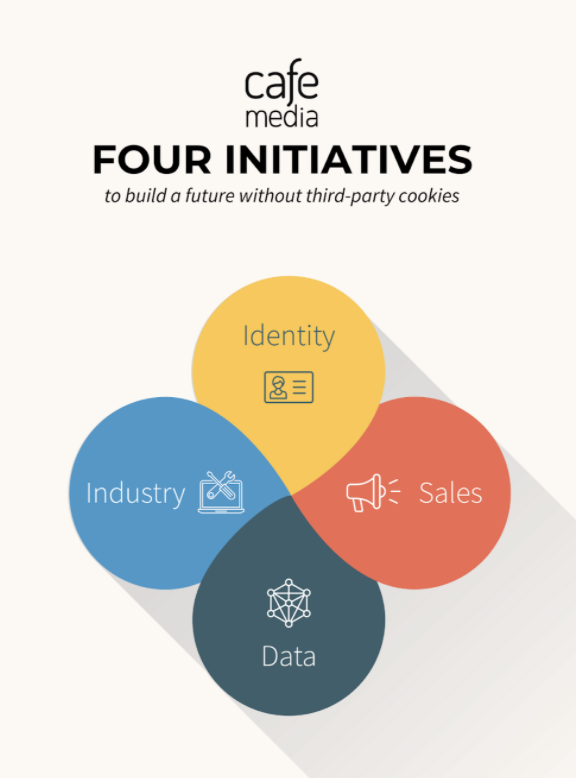Your top questions about third-party cookies
As we’ve been sharing lots of content on how we’re building a future for digital advertising that doesn’t rely on third-party cookies, we’ve been getting tons of great questions from CafeMedia publishers. It’s a big and complex topic and there’s a...

As we’ve been sharing lots of content on how we’re building a future for digital advertising that doesn’t rely on third-party cookies, we’ve been getting tons of great questions from CafeMedia publishers.
It’s a big and complex topic and there’s a lot to digest — so today, we’re answering the top questions we’ve received about third-party cookies. No one has all the answers yet, but we’ll share what we know right now and what we expect for the future, and keep you updated as new info unfolds.
- Why is the third-party cookie going away?
- When is the third-party cookie going away?
- Just how big is the cookie crash going to be?
- What is CafeMedia doing to protect against a revenue drop in a world without third-party cookies?
- What can I do today to limit the financial impact when Google sunsets third-party cookies?
Why is the third-party cookie going away?
Here we explain more about what the third-party cookie is overall.
Digital advertising relies heavily on third-party cookies to drive advertisers’ understanding of individuals on the internet. For example, what they’re interested in, where they’re shopping, their purchase history with the brand.
People are more aware of their online privacy than ever, and they want more control over who has information about them and how it’s used.
The so-called “death of the cookie” is a bit of a misnomer since most major browsers already don’t support third-party cookies because of privacy concerns. Google Chrome is the last holdout but is slated to sunset third-party cookies by 2022. Since the Chrome browser represents a huge chunk of internet users, this puts the final nail in the third-party cookie coffin (or will, in 2022).
When is the third-party cookie going away?
This is one of those questions that we can’t answer specifically just yet.
Google’s announcement in January 2020 pegged 2022 as a target date:
Once these approaches have addressed the needs of users, publishers, and advertisers, and we have developed the tools to mitigate workarounds, we plan to phase out support for third-party cookies in Chrome. Our intention is to do this within two years.
But, Google has also indicated it won’t cut off third-party cookie support without a viable substitute in place (AdExchanger, The Drum).
Google’s Privacy Sandbox proposals are currently in testing (and we’re participating), so it remains to be seen how effectively these new methods can replace today’s ad targeting, measurement, and reporting capabilities that rely on third-party cookies.
But we and the rest of the industry are still anticipating this to happen sometime in 2022.
Just how big is the cookie crash going to be?
This is another one of those questions that doesn’t have a definitive answer yet — and that’s great news for publishers.
No definitive answer means it’s good to be aware (and understandable to be concerned), but you don’t need to panic. We’re on the front lines of industry efforts, so we’ll lay it all out for you, make sure you have all the info you need, and share simple to-dos with you when there are steps publishers can take to prepare.
In terms of a worst-case scenario, when Firefox and Safari stopped supporting third-party cookies, CPMs (advertiser spending) fell 50% for traffic using those browsers because there weren’t reliable substitutes in place.
But no one wants to see that happen for Chrome — it would be bad for marketers and advertisers, publishers, ad technology companies, and ad management companies alike! There are massive collaborative efforts across the industry to establish effective third-party cookie replacements and avoid a catastrophic decrease.
It’s also possible that other browsers adopt some of what Chrome is doing with the Privacy Sandbox, increasing the value of traffic that’s pretty low-value today.
And our other company focuses like email identity, contextual data, and direct sales have benefits for all of your traffic, not just the percentage of traffic coming from Chrome users.
What is CafeMedia doing to protect against a revenue drop in a world without third-party cookies?
We’re taking a comprehensive approach.
While other ad management companies seem to be focusing all their efforts on one specific area (like logged-in users), we know that there isn’t one single “solution” for a future without third-party cookies.
We wish it was as easy as just putting a specific piece of tech up on your site.
But relying on one particular piece of technology is kind of what got our industry into this mess — so while it may be a piece of the puzzle, as with all things in business, it’s important to diversify.

That’s why we’re investing in four critical initiatives:
- Industry advocacy — with team members deeply involved in key trade groups and organizations, working toward industry-wide outcomes that are in your best interest. And when even Google is linking to resources we put together about the Privacy Sandbox, and Wired is referencing our breaking news on WordPress and FLoC, you can trust we have some great minds focused on this stuff!
- Identity solutions — focused on email-based identity to start. 1) Because that’s where we find the majority of advertiser interest and 2) because email is such a powerful way for you to build your owned audience and bring valuable readers back again and again.
- Data — It drives your ad performance and the custom ad layout we optimize for your site, fuels the content insights we share with you, and is something our ad partners value deeply. With years of investments into AI-powered contextual data with our platform Marmalade, we’re able to bring advertisers smart and privacy-conscious targeting capabilities that rival the efficacy they get with third-party cookies.
- Sales — One of the best ways to preserve revenue post-third-party cookies, and an area where we are uniquely strong. It takes years to build strong relationships with brands and agencies and prove overwhelming value, but our sales team has a big head start on other ad companies that are just now expanding into direct sales. Direct sales raise your RPM today and will only become more important, which is why we’re so focused on growing this area of our company further this year.
What can I do today to limit the financial impact when Google sunsets third-party cookies?
Now you know what CafeMedia is focused on, but what can you do to make sure you enter a future without third-party cookies in the best possible position.
Is there a checklist?
You bet!
But fair warning, this checklist is less about third-party cookies and more about things that are awesome investments in your business at any time. Since we’re doing the heavy lifting on the industry, technology, data, and sales fronts for you, the most valuable use of your time is focusing on strategies that grow and diversify your traffic.
- Keep optimizing your content for discovery. Like the COVID-19 pandemic showed us all, traffic growth can help cancel out dips in advertiser spending. So as you’re looking to future-proof your business, spend time on strategies that help new people discover your content. Focus on site experience, create content that meets trending interest, spend your time strengthening your existing content portfolio and optimizing your content for search engines like Google and Pinterest.
- Turn on CafeMedia Email Identity. Once enabled, when your readers enter email addresses anywhere on your domain, our ad code can turn them into anonymous identifiers that drive higher advertiser spending when that reader returns.
- Supercharge your email acquisition strategy. With CafeMedia Email Identity running, it’s time to focus on feeding that list of valuable identified readers. How can you engage each visitor to your site? What can you offer them that convinces them to start a relationship with you — whether that’s leaving a comment, participating in a discussion thread, or joining your email list?
- Make sure you have a way to bring those identified readers back to your site. An email list is a great way to do this, since you have a reason to pop into someone’s inbox and the opportunity to drive them straight back to your site. Wherever you are with email marketing — whether you’re just sending out RSS notifications of new blog posts or you have a solid segmentation and automation strategy — look for ways to up your game and build your relationship with your audience. Remember: they’re only valuable for identity purposes when they return to your site.
- Give your loyal readers a great experience on your site. We’ve actually come full circle back to step 1 — the things that help you attract new readers also show your loyal readers that you value their support. Google’s new Core Web Vitals metrics can put measurable numbers to the reader experience on your site. Is it loading quickly? Is it usable? Is it stable? And spending time to experience your site the way your readers do can help you make decisions that encourage them to spend more time on your site and come back again and again!
_______
Have more questions about third-party cookies? Simply email your Account Manager, or contact us here, and we’ll answer more FAQs soon.
